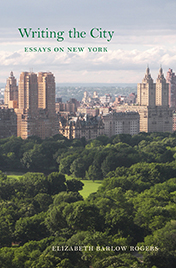September 16th, 2022
Writing the City
 I am very pleased that my twelfth book Writing the City: A Collection of Essays on New York will join the fine list of more than fifty books published by the Library of American Landscape History since its founding by Robin Karson in 1992.
I am very pleased that my twelfth book Writing the City: A Collection of Essays on New York will join the fine list of more than fifty books published by the Library of American Landscape History since its founding by Robin Karson in 1992.
I have been affiliated with LALH for thirty years, both as a board member and a contributor to its magazine VIEW. During this time it has been a privilege for me to follow Robin’s mission to build a library in a field where there was no serious literature based on scholarly research about the careers of professional landscape architects from the period following Frederick Law Olmsted’s role as father of this profession up to the present day. With over 50 books published to date, LALH has furthered that ambitious goal to a large extent. In addition to the careers post-Olmsted landscape architects, LALH’s publishing agenda has brought to light the theories, commissions, and legacies of the creators of the National Parks and the design principles and achievements of Modern landscape architects. Recently LALH has begun to publish books of landscape-related essays by distinguished contemporary practitioners such as Laurie Olin, notable landscape stewards such as Gregory Long, the former president of New York Botanical Garden, and landscape historians such as myself.
Recently Jonathan Lippincott, a professional book designer with a reputation as a talented graphic designer, has assumed the LALH title of publisher. You will get a sense of his expertise in this area when you pick up my book, look at its dust jacket, and then open its pages and notice the fine Sabon text font and layout of the illustrations. You should note also that, while assuming the title of publisher, Jonathan remains the graphic designer of all of LALH’s beautiful brochures and other print publications, including VIEW magazine. With Robin’s continuing role as editorial director, this outstanding not-for-profit organization continues to serve the community of professional landscape historians and general readers with an interest in well-written books on gardens, parks, and city planning.
It is Robin who chose the title for my book after I gave her a description of the contents of the several boxes of old manuscripts and saved magazines and journals dating back to the early 1970s that I had taken out of my Long Island house when it was sold.
Here is a side-note. One reason for my partiality to the title Writing New York is because it chimes with Writing the Garden, the book I published with the New York Society Library in 2011 to complement the exhibition that Harriet Shapiro, the Library’s historian, and I co-curated.
I like the way Robin helped me winnow down thirty some-odd vintage manuscripts to thirteen that are specifically about my enthusiastically adopted home, New York City, where I have lived since 1964. Several of these were published in New York Magazine, including one that confirmed that I could succeed in fundraising for the cause that led to my founding of the Central Park Conservancy.
The book goes beyond the boundaries of the City to deal with its formidable infrastructure, two great natural history institutions – the New York Botanical Garden and the American Museum of Natural History where I discuss the dioramas, which I think of as great works of art. I also write about the history of Green-Wood Cemetery as a scenic landscape that influenced Frederick Law Olmsted and Calvert Vaux’s Romantic designs for Central Park and Prospect Park. New York’s 520-mile waterfront couldn’t be ignored, so there is an article that I first published in Smithsonian Magazine on the creation of South Street Seaport and one that I wrote later on Brooklyn Bridge Park for the Cityscape News.
Divided into three parts, the book deals with New York’s rich original endowment by nature; gives a tour of some significant parts of its 520-mile shoreline of riverfronts, bays, wetlands, and the Atlantic Coastline; and provides a design history of certain notable green spaces within its urban confines. I am very grateful to the Library of American Landscape History for the opportunity to republish my writings on New York’s incomparable landscape history by assembling the essays contained in this book.
Share
